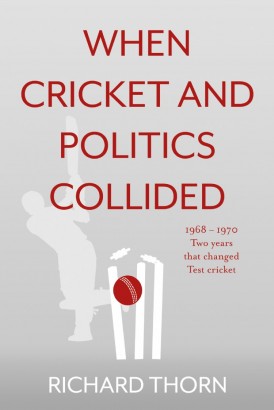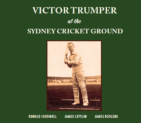When Cricket and Politics Collided
Martin Chandler |Published: 2021
Pages: 309
Author: Thorn, Richard
Publisher: Matador
Rating: 3.5 stars

With three books, all different in approach, appearing last year to mark the fiftieth anniversary of the campaign to stop the South Africans’ 1970 tour of England my initial thought on seeing When Cricket and Politics Collide was to wonder whether a fourth could add a great deal to the story.
Author Richard Thorn is a retired academic, during which career his subject was computer engineering. His only previous book is a biography of another engineer who could write, Neville Shute. The man himself would probably find the comparison somewhat odious, but like Shute Thorn may be an engineer, but he is also a talented wordsmith, albeit in his case his writing has, so far, been strictly non-fiction.
The difference between When Cricket and Politics Collide and last year’s books from Mark Rowe, Colin Shindler and Arunabha Sengupta is that whilst they dealt directly with the ultimately aborted visit to England of the 1970 South Africans, Thorn concentrates on the consequences. There is, naturally, some common ground and Thorn duly covers that but he concentrates on the two series of matches that replaced the South African series due to take place in 1968/69 and 1970, being England’s visit to Pakistan in 1968/69, and the five matches arranged for the 1970 English summer involving a Rest of the World XI.
There is a book on the trip to Pakistan (Sporting Wickets), but it was published locally in Pakistan by Qamaruddin Butt and, besides being hard to find and costly when a copy is tracked down, is essentially a traditional tour account. The trip itself was anything but traditional however, played against a backdrop of political unrest in a country that, looking back, was a veritable powder keg, and liable to explode at any moment.
In putting together his account of that tour, and the England’s side’s initial visit to the comparatively calm but still far from trouble free Ceylon (as Sri Lanka was then known) Thorn has skilfully and concisely explained the political background in the two countries, before updating on an almost daily basis the security crises that tour manager Les Ames had to deal with. In a situation where no modern touring party would even leave their own country the burden placed on the shoulders of the former Kent wicketkeeper was huge, and he was given no real support, whether from Lord’s or Westminster.
Thorn’s account of the trip is a compelling one and there can be no doubt but that he has produced an excellent account of an interesting series that was not televised in England, and in respect of which the UK public had little idea of what was really going on. A number of the England players have subsequently given some sort of account of their experiences, and whilst later writings and interviews have been picked up on it is, perhaps, a pity that none of the surviving players appear to have been interviewed in the course of the book being written.
As with the series in Pakistan no contemporary writer produced an account of the series of matches against the Rest of the World. That in itself is surprising, and the more so that it has taken half a century for that wrong to be righted. But these matches were a different kettle of fish altogether. Although their status was downgraded by the ICC just two years later they were billed at the time as full Tests, and played and televised as such.
More than that however the Rest’s side, led by the mighty Garry Sobers, was an immensely powerful combination and whilst they, unsurprisingly, took the series 4-1, Ray Illingworth led his England side well and the series was not as one sided as the scoreline suggests, and was studded with some superb individual performances. No one over the age of sixty who watched those games will ever forget them, and therefore Thorn has a different sort of challenge in reconstructing those events, but one that he accomplishes equally well.
Although the centrepiece of the book is its account of these two under reported series events off the field both before during and after are highly relevant and create the context in which the cricket was played, something particularly important for readers who did not live through the late 1960s and early 1970s. Thorn’s background chapters are as well written as his accounts of the matches and create a seamless narrative.
Ultimately the book would have benefitted, as indicated, from some input from the players involved on all sides, and from a few more than the five photographs that appear at the end. That said the book is, as far as I could see, very well proof read and free from errors and, for those without a Cricketarchive subscription, it contains all the scorecards and has an excellent index.
At the very end of the book the acknowledgements appear, and towards the end of those Thorn produces an absolute ripper of a quotation that I have not heard before:-
I realise very well that the reader has no great need to know all this, but I need to tell him.
He goes on to then express the hope that his cricket loving reader realises after reading When Cricket and Politics Collided that in fact he did need to know after all – I can assure him that at least in the case of this reviewer, he certainly did.






Leave a comment